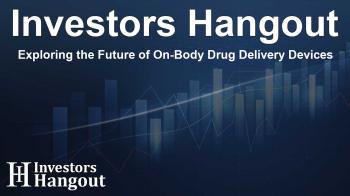Exploring the Future of On-Body Drug Delivery Devices

Transforming Healthcare with On-Body Drug Delivery Devices
The global on-body drug delivery devices market is undergoing a significant transformation, enhancing patient care by offering innovative solutions for self-administering therapies. These advancements are especially important for chronic conditions such as diabetes and cancer. In the current year, this market is valued at approximately US$ 390.7 million, and projections indicate it could climb to an incredible US$ 796.1 million by 2034, marking a commendable growth rate of 6.8% CAGR.
Understanding the Market Landscape
On-body drug delivery devices aim to streamline the administration of medications, making it easier for patients to manage their health. The rise in self-administered therapies reflects a shift towards a more patient-centric healthcare system. Major companies, including BD, Insulet, and Medtronic, are central players driving this trend by developing next-generation devices that are not only smart but also adaptable to various treatment needs.
Market Dynamics and Growth Drivers
The appeal of on-body drug delivery devices extends across multiple therapeutic areas, with diabetes care particularly dominant, holding approximately 40% of the market share. As chronic diseases become more prevalent worldwide—affecting nearly 60% of adults—demand for these innovative solutions is escalating. Moreover, the aging population is another critical factor that boosts this industry's growth, with expectations that by mid-century, a substantial segment of the global populace will be over 60 years old.
Technological Innovations Shaping Patient Care
At the heart of this market's expansion lies technological innovation. Today's on-body devices are equipped with features such as Bluetooth connectivity and dose-tracking capabilities, enhancing both usability and patient compliance. The incorporation of smart apps enables users to track their medication usage, improving adherence to treatment plans and overall health outcomes.
Key Players at the Forefront
Prominent organizations in this field, such as Enable Injections, Inc., and Gerresheimer AG, continuously invest in developing advanced technologies and gaining regulatory approvals for their products. For instance, Becton, Dickinson and Company (BD) recently introduced the BD Libertas™ Wearable Injector, tailored for biologics, while Insulet Corporation has collaborated with Dexcom to enhance diabetes management through integrated devices.
Regional Insights and Trends
North America remains a dominant region in the on-body drug delivery devices market, driven by a highly developed healthcare infrastructure and early adoption of cutting-edge technologies. Europe follows closely, benefitting from robust regulatory frameworks that support innovation. Asia-Pacific represents the fastest-growing market, fueled by rising healthcare access and an increase in diabetes cases, particularly in nations such as India and China.
Market Challenges Ahead
Despite the positive outlook for the on-body drug delivery devices market, challenges remain. High development costs and regulatory hurdles can impede market entry for new products. Companies are required to navigate complex approval processes to ensure safety and efficacy, which can slow down innovation.
Future Outlook and Emerging Opportunities
Looking ahead, the on-body drug delivery devices market is poised for sustained growth due to several key opportunities. The integration of artificial intelligence (AI) and the Internet of Things (IoT) into these devices promises to enhance personalization and connectivity with healthcare providers. Furthermore, the growing sector of biologic therapies necessitates advanced delivery methods, solidifying the importance of on-body devices.
Conclusion: An Exciting Road Ahead
The shift toward patient-friendly healthcare, alongside technological advancements, positions the on-body drug delivery devices market for ongoing expansion. As more patients turn to self-administration for managing chronic conditions, the demand for innovative, effective, and user-friendly solutions will continue to rise.
Frequently Asked Questions
Q1. What is driving the growth of on-body drug delivery devices?
The increasing prevalence of chronic diseases, the aging population, and the growing preference for home-based care significantly contribute to market growth.
Q2. Which region leads the market?
North America leads the market due to high healthcare spending and a significant incidence of chronic diseases, particularly diabetes.
Q3. What are the challenges for this market?
Challenges include high development and production costs, as well as complex regulatory environments that companies must navigate.
Q4. How do technological advancements affect this market?
Innovations such as smart connectivity, real-time monitoring, and the use of biodegradable materials improve user experience and device sustainability.
Q5. What therapeutic area does on-body drug delivery primarily target?
The market primarily targets diabetes care, driven by the widespread dependency on insulin and other related treatments.
About The Author
Contact Lucas Young privately here. Or send an email with ATTN: Lucas Young as the subject to contact@investorshangout.com.
About Investors Hangout
Investors Hangout is a leading online stock forum for financial discussion and learning, offering a wide range of free tools and resources. It draws in traders of all levels, who exchange market knowledge, investigate trading tactics, and keep an eye on industry developments in real time. Featuring financial articles, stock message boards, quotes, charts, company profiles, and live news updates. Through cooperative learning and a wealth of informational resources, it helps users from novices creating their first portfolios to experts honing their techniques. Join Investors Hangout today: https://investorshangout.com/
The content of this article is based on factual, publicly available information and does not represent legal, financial, or investment advice. Investors Hangout does not offer financial advice, and the author is not a licensed financial advisor. Consult a qualified advisor before making any financial or investment decisions based on this article. This article should not be considered advice to purchase, sell, or hold any securities or other investments. If any of the material provided here is inaccurate, please contact us for corrections.

